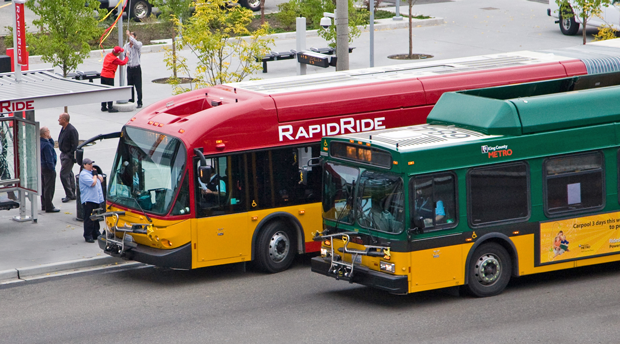By Tracy Record
West Seattle Blog editor
 Metro‘s proposed restructuring of West Seattle’s route system is an emotional topic for some.
Metro‘s proposed restructuring of West Seattle’s route system is an emotional topic for some.
That was clear when what Metro calls its “concepts” for change came out last week, drawing triple-digit reaction here.
It was also clear last night when things got somewhat testy among community members who came to the Southwest District Council meeting for the first chance to hear from Metro reps, before two events in West Seattle on November 9th and 17th.
The Metro discussion was part of a one-two transit-related punch that took up most of the meeting, starting with an SDOT update on road changes to accommodate Metro’s RapidRide, the new style of bus service that also is the reason for the planned route restructuring. Some of those changes were questioned pointedly by SWDC members, too.
Jonathan Dong from SDOT briefly recapped the “rechannelization” work that has been, and will be, done to create transit lanes on two West Seattle streets. The 6-10 am bus-only lane on northbound Avalon Way, just south of the bridge, was finished by mid-October. The SW Alaska work (previously reported here), which will bring changes from 35th to California, is expected to be done next spring, he said.
What raised the most eyebrows was his update on “bus bulbs” meant to enable buses to stop in-lane instead of pulling over and pulling back out into traffic. They are planned in more than half a dozen places along the route of RapidRide Line C, including California/Findlay and California/Fauntleroy, with the latter drawing more than a few questions (the “bulbs” will be on the east side of California by Washington Federal Savings, and the north side of Fauntleroy by Zeeks Pizza). The Morgan Community Association‘s rep Chas Redmond was worried the bus bulbs – with other lines using them too – would back up traffic on California. Fauntleroy Community Association rep Vlad Oustimovitch noted that the FCA has been working with project managers a long time to make sure the bus bulbs on Fauntleroy by the ferry terminal don’t cause a traffic nightmare there.
Metro service-planning manager David Hull, one of three Metro reps at the meeting, said the point was to reduce “dwell time” – how long the bus sits at the curb, to keep up with a “frequent service” plan for RapidRide. Redmond warned, “We don’t want Metro to destroy a perfectly functioning peninsula (transportation system).” But in the end, though there were some murmurings about revisiting the plan, Dong said SDOT had finished design of the bus bulbs and planned to break ground “before the end of the year.” The city has prioritized transit, he pointed out.
That led into the Metro presentation, with Hull, Doug Johnson, and DeAnna Martin on hand. (You can see it in its entirety in our clip above – forgive some of the camera angles when we had viewfinder trouble.)
To recap – here’s the link to the first draft of potential changes. Hull stressed that “these are concepts. We are putting them out there because we want to hear what people think. We are looking at the system as a whole to be more efficient and more effective. We should run a system that is productive.” That also means, he said, using a “data-based approach … we want to show you the numbers.”
To create a productive system, he said, “there will be trade-offs – you might go to the same place, but need a transfer.”
Several of the community members on hand were concerned about that – trips that no longer would go transferless.
Some of the major changes summarized included those discussed when the early “concept” came out – Route 21 ending at Westwood instead of serving Arbor Heights. One AH resident on hand spoke in strong opposition to the change, saying that while AH would have “peak” service, that “peak” didn’t work for many people with unconventional working hours, or older residents who need public transit to get around. He accused Metro of not listening; they assured him they are listening, and that what they heard from him was, “Arbor Heights needs service.”
Other questions included the reduction in service for North Admiral. “I’ll be in my car,” one woman declared, if that happens.
No one asked about the plan to cut Route 37, leaving Beach Drive without bus service – but then again, this wasn’t one of the full-blown formal hearings, it was just a briefing for the Southwest District Council, more to explain the philosophy behind the plan than the plan itself.
The big meetings are next Wednesday (November 9th) at Chief Sealth International High School and eight days after that (Thursday, November 17th) at Madison Middle School, both at 6:30 pm.
There is a lot of talking to be done; even after the end of the discussion during the SWDC meeting, the community members converged on the Metro reps and had to be sent out into the hall so the council meeting could continue. You don’t have to wait for meetings to have your say; you can work your way through Metro’s Have a Say website and take a survey, send comments, etc. A final decision on route/service changes is not due until next spring, and they would take effect by the time RapidRide launches next September.

| 29 COMMENTS